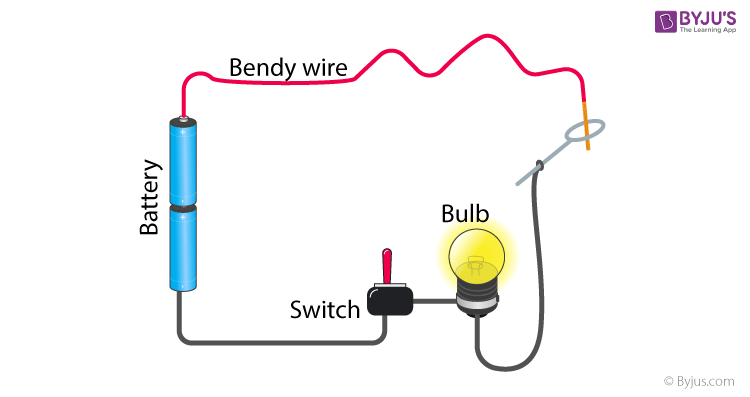Electrical circuits are virtually represented by circuit diagrams and electrical symbols. The pictorial representation of various electrical devices in a circuit diagram is known as an electrical symbol. Some unique electrical symbols denote various electrical components in a circuit, and these symbols are largely standardised. This article will acquaint you with the most frequently used electrical symbols for constructing and analysing circuit diagrams.
| Table of Contents: |
What is an Electric Circuit?
A system of conducting elements that are designed to conduct electric current for a particular purpose is known as an electric circuit. An electric circuit consists of a source of electrical energy; elements that either transform, dissipate, or store this energy; connecting wires. To prevent power overload, circuits often include a fuse or circuit breakers.

A Short History of Circuits and Systems
The first electric circuit was invented by Alessandro Volta in 1800. Volta discovered that he could produce a steady flow of electricity using bowls of salt solution connected by metal strips. Later, he used alternating discs of copper, zinc, and cardboard that had been soaked in a salt solution to create his voltaic pile (an early battery). He successfully made the electric current flow through the circuit by attaching a wire running from top to bottom. The first practical use of electric current was employed in electrolysis, which further led to the development of new chemical elements.
Components of an Electric Circuit

Electric circuits are amazing. Have you ever seen the game of Steady Hands? It is a circuit with a twisty wire between two points. The point of the game is to move a metallic object from one end of the electric wire to the other. If you touch the wire while moving this metallic object, the circuit buzzes, and you are out. It’s a fun game that can be made with stuff you can find at home. Let’s analyze an electric circuit and dive deeper into its components.
See the video below to understand the flow of the current

List of Electrical Components With Symbols
An electrical symbol is a graphical representation of electrical and electronic components. These symbols help us recognise a particular electronic device in a circuit. National and international standards define electrical symbols. Circuit symbols only represent the components of electrical and electronic circuits and do not define their function or process.
Let us have a look at how various components in a circuit are denoted:
Electrical Wire
A wire is a single, usually cylindrical, flexible strand or rod of metal through which electric current flows. It is usually made of good conducting metals such as copper.

Connected Wire
Connecting wires provide a medium to an electrical current so that they can travel from one point on a circuit to another.

Disconnected Wire
In diagrams, we come across situations where we have wires crossing through other wires even though they are not connected to each other. Hence, it is preferred to have a hump as shown to depict the crossing of one wire over another wire.

Earth Ground
The reference point in an electrical circuit from which voltages are measured, a common return path for electric current, or a direct physical connection to the earth.

Chassis Ground
Chassis ground is the metal housing that some electrical device is encased in. The chassis may be connected to the green ground wire of your power lines.

Digital/Common Ground
The reference voltage of digital logic ICs. This means that no analogue signals are coupled into this reference plane.

Lamp/Light Bulb
It is a load that uses electric current to emanate light.

Resistor (IEE)/(IEC)
A resistor is a device that resists the flow of current through a circuit.

Variable Resistor/ Rheostat (IEE)/(IEC)
A variable resistor is a resistor whose electrical resistance can be adjusted. A rheostat is a variable resistor whose resistance can be varied to control the current in the circuit.

Potentiometer (IEE)/(IEC)
A potentiometer is a three-terminal resistor with a sliding or rotating contact that forms an adjustable voltage divider.

Photoresistor/ Light-dependent resistor (LDR)
Photresisor decreases resistance with respect to receiving luminosity.

Thermistor
A thermistor is a type of resistor whose resistance is dependent on temperature.

Capacitor
A capacitor is a device that stores electrical energy in an electric field.

Variable Capacitor
A variable capacitor is a capacitor whose capacitance may be intentionally and repeatedly changed mechanically or electronically.

Polarized Capacitor
A capacitor whose anode is made of metal forms an insulating oxide layer through anodisation.

Voltage Source/ Current Source
A voltage source is an electrical component that can maintain a fixed voltage irrespective of the load resistance and output current.

Battery Cell/ Battery
A battery is a device that consists of two or more electrochemical cells with external connections.

AC Voltage Source
It is a source hose positive and negative terminals change periodically.

Controlled Voltage Source/ Controlled Current Source
A current-controlled voltage source produces a voltage that is linearly proportional to the current. A controlled or dependent current source, on the other hand, changes its available current depending upon the voltage.

Voltmeter
The voltmeter is an instrument for measuring electrical potential.

Ammeter
The Ammeter is an instrument for measuring electric current.

Diode
The diode is a semiconductor device with two terminals that allows current to flow only in one direction.

Zener Diode
The Zener diode is a type of diode that allows the flow of reverse current when it reaches a certain Zener voltage.

Schottky Diode
The Schottky Diode is a diode formed by the junction of a semiconductor with a metal.

Varicap Diode
The Varicap diode is a type of diode designed to exploit the voltage-dependent capacitance of a reverse-biased p–n junction.

Photodiode
The photodiode is a type of semiconductor device that converts light into an electrical current.

NPN Bipolar Transistor
The NPN bipolar transistor is the transistor in which one p-type material is placed between two n-type materials.

PNP Bipolar Transistor
PNP bipolar transistor is the transistor in which one n-type material is placed between two p-type materials.

OR/NOR Gate
OR gate performs a logical operation which gives the value one if at least one operand has the value one and otherwise gives a value of zero.
NOR gives the value one if and only if all operands have a value of zero and otherwise has a value of zero.

AND/NAND Gate
AND gate gives the value one if and only if all the operands are one, and otherwise has a value of zero.
NAND gate gives the value zero if and only if all the operands have a value of one, and otherwise have a value of one.

XOR/ NOT Gate
XOR gate is a digital logic gate that gives a true output when the number of true inputs is odd.
NOT gate is a logic gate which implements logical negation.

Watch the video and solve important questions in the chapter Electricity Class 10

Frequently Asked Questions – FAQs
What is a motor?
A motor is a device that can convert electrical energy into mechanical energy.
What is a photodiode?
A type of semiconductor device that converts light into an electrical current.
What are electrical symbols?
Electrical symbols are a graphical representation of electrical and electronic components.
Which conducting material is used in electrical wires?
What is an electrical fuse?
A fuse is a protective device that protects circuits against the flow of excess electrical current. A fuse symbol is used to represent the fuse in the circuit.
Hope you have learned in detail electrical symbols. Stay tuned to BYJU’S and FALL in Love with Learning! Watch more interactive videos and make learning a lifetime experience. Download BYJU’S – The Learning App.

great